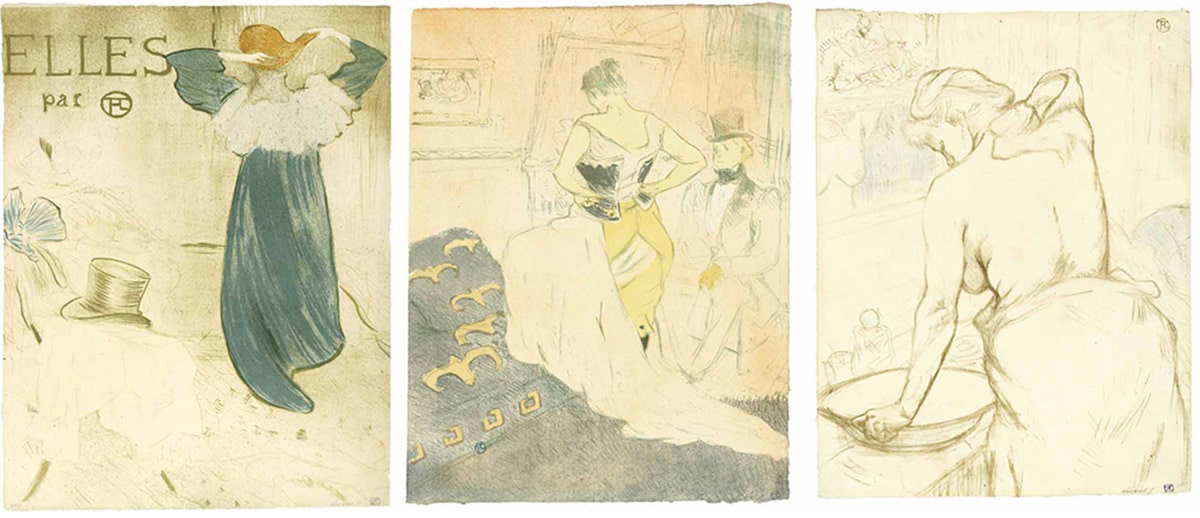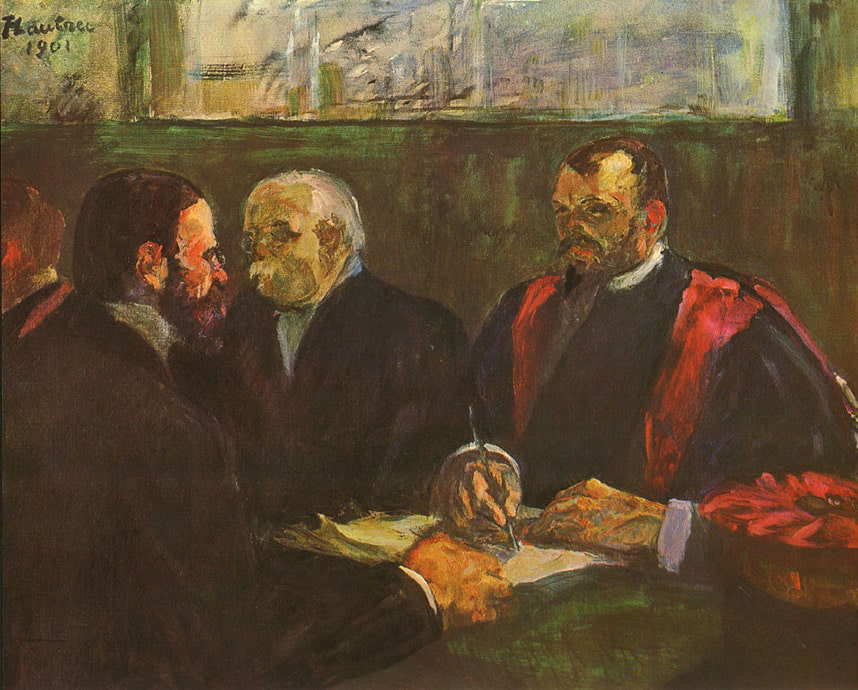
Henri de Toulouse-Lautrec is a prominent Post-Impressionist painter, art nouveau illustrator and printmaker. The artist spent most of his time frequenting the cafes and cabarets of the Montmartre neighborhood, and his paintings of these places are famous evidence of late nineteenth century Parisian life. The outward appearance of the city of Paris during the Belle Époche is deceiving.
Toulouse-Lautrec’s artwork highlights that underneath the glittering facade was a shady, almost universal participation with the seedy underbelly of the city that was quintessential to the fin-de-siècle, or turn of the century. Learn how the life of Toulouse-Lautrec led him to create some of the most iconic images of modern Parisian life.
Henri de Toulouse-Lautrec’s Early Years

Henri de Toulouse-Lautrec was born November 24, 1864 in Albi, Tarn in Southern France. While the artist is remembered as being an outlier of society, he was actually born into an aristocratic family. He was the firstborn child of Comte Alphonse and Comtesse Adèle de Toulouse-Lautrec-Monfa. Baby Henri also held the title of Comte like his father, and he would have lived to eventually become the esteemed Comte de Toulouse-Lautrec. However, the young life of little Henri would lead him down a very different road.
Toulouse-Lautrec had a troubled upbringing. He was born with serious congenital health conditions which could be attributed to an aristocratic tradition of inbreeding. Even his parents, the Comte and Comtesse, were first cousins. Henri also had a younger brother born in 1867, who only survived until the following year. After the strain of a sick child and the difficulties of losing another, Toulouse-Lautrec’s parents separated and a nanny took on the main role of raising him.

It was when Toulouse-Lautrec moved with his mother to Paris at the age of eight that he took up drawing. Sketching and drawing caricatures were young Henri’s main escape. His family saw his talent and allowed him to pursue drawing and painting, getting him informal art lessons from his father’s friends. It was in his early paintings that Toulouse-Lautrec discovered one of his favorite subjects, horses, which he frequently revisited throughout his life as can be seen in his later “Circus Paintings.”
Get the latest articles delivered to your inbox
Sign up to our Free Weekly Newsletter
The Formation Of An Artist

But at the age of thirteen, things got much harder for young Henri when he fractured both his femurs in subsequent years and neither of the breaks healed properly because of an unknown genetic disorder. Modern doctors have speculated on the nature of the disorder, and many agree that it was likely pycnodysostosis, which is frequently called Toulouse-Lautrec syndrome. Worrying for his health, his mother brought him back to Albi in 1975 so that he could rest in the thermal baths and see doctors who hoped to improve his development and growth. But unfortunately, the injuries permanently halted the growth of his legs so that Henri developed a full adult torso while his legs remained child sized for the rest of his life. He was extremely short as an adult, only ever growing to 4’8”.
His disorder meant the young Toulouse-Lautrec felt frequently isolated from his peers. He could not participate in many activities with other boys his age, and he was shunned and bullied because of his appearance. But this was very formative for Toulouse-Lautrec, because he once again turned to art to deal with his emotions and immersed himself in his artistic education as an escape. So while it is incredibly sad to imagine a boy in his situation, without these experiences he may not have become the famous and loved artist that he is remembered as today.
Life In Paris

Toulouse-Lautrec moved back to Paris in 1882 to continue to pursue his art. His parents hoped that their son would become a fashionable and respected portrait painter, and sent him to study under the renowned portrait painter Léon Bonnat. But the strict academic structure of Bonnat’s workshop did not suit Toulouse-Lautrec and he turned away from his family’s wishes for him to be a “gentleman” artist. In 1883, he moved on to study in the studio of artist Fernand Cormon for five years, whose instruction was more relaxed than many other teachers. Here he met and befriended other like-minded artists like Vincent Van Gogh. And while in Cormon’s studio, Toulouse-Lautrec was given the freedom to roam and explore Paris and be inspired to develop his own personal artistic style.
It was at this time that Toulouse-Lautrec was first drawn into the Parisian neighborhood of Montmartre. Fin-de-siecle Montmartre was a bohemian neighborhood of low rent and cheap wine which drew the marginal members of Parisian society. It was the center of artistic movements like the décadent, absurd, grotesque and most notably, the Bohemian. Coined from the old Bohemian tradition of eastern European wanderers, modern French Bohemia was the ideology of those who desired to live outside of normative society, and the restraints that they believed it entailed. Montmartre thus became the home of the nonconformist artists, writers, philosophers and performers of Paris – and over the years it was a place of inspiration for extraordinary artists like Auguste Renoir, Paul Cézanne, Edgar Degas, Vincent Van Gogh, Georges Seurat, Pablo Picasso and Henri Matisse. Toulouse-Lautrec would also adopt Bohemian ideals and make his home in Montmartre, and he would rarely leave the area for the next twenty years.
Toulouse-Lautrec’s Muses

Montmartre was Toulouse-Lautrec’s artistic muse. The neighborhood was associated with the “demi-monde,” or shady underbelly of the city. Nineteenth century Paris was an expanding city, with a massive influx of workers from the industrial revolution. Unable to provide, the city became home to poverty and crime. People stricken by this were led to make their living in more unsavory ways, and thus a Parisian underworld grew in Montmartre. Prostitutes, gamblers, drinkers, those forced to live on the outskirts of the city based off of their means attracted the attention of the Bohemians such as Toulouse-Lautrec, who were fascinated by the strangeness of these lives. They were inspired by how different these people lived from “normal” society.
It was here that Toulouse-Lautrec had his first encounter with a prostitute, and he came to frequent the brothels of Montmartre. The artist was inspired by the girls. He painted a number of works, around fifty paintings and a hundred drawings, featuring the prostitutes of Montmartre as his models. Fellow artist Édouard Vuillard said that “Lautrec was too proud to submit to his lot, as a physical freak, an aristocrat cut off from his kind by his grotesque appearance. He found an affinity between his condition and the moral penury of the prostitute.” In 1896, Toulouse-Lautrec executed the series Elles which was one of the first sensitive portrayals of brothel life. In these paintings, he evoked sympathy for the isolated and lonely women with whom he shared so many experiences.

Toulouse-Lautrec was also inspired by the cabarets of Montmartre. The neighborhood hosted a notorious nightlife, with performance halls like the Moulin de la Galette, Chat Noir, and the Moulin Rouge that were known for putting on scandalous performances, that many times mocked and critiqued modern life. These halls were a place for people to mix. While most of society had looked down on the artist, he felt welcomed in places such as the cabarets. In fact, when the infamous Moulin Rouge opened in 1889, they commissioned him to create the posters for their advertisements. They displayed his paintings and he always had a reserved seat. He was able to see and depict performances by popular entertainers such as Jane Avril, Yvette Guilbert, Loie Fuller, Aristide Bruant, May Milton, May Belfort, Valentin le Désossé and Louise Weber who created the French can-can. The art that Toulouse-Lautrec based on the entertainers of Montmartre have become some of the artist’s most iconic images.
Final Years

Despite finding an outlet in art and a home in Montmartre, a lifetime of being mocked for his physical appearance and short stature led Toulouse-Lautrec into alcoholism. The artist popularized cocktails and was known for getting drunk off “earthquake cocktails” which were a strong mixture of absinthe and cognac. He even hollowed out the cane which he used to aid his underdeveloped legs so that he could fill it with liquor.
After a collapse in 1899 brought on by his alcoholism, his family committed him to a sanatorium just outside Paris for three months. He drew a whopping thirty-nine circus portraits while committed, and upon his release he traveled throughout France continuing to make art. But by 1901, the artist succumbed to alcoholism and syphilis which he had contracted from a Montmartre prostitute. He was only thirty-six. Reportedly, his last words were “Le vieux con!” (the old fool!).

Toulouse-Lautrec’s mother had a museum constructed in his hometown of Albi to display her son’s artwork, and the Musée Toulouse-Lautrec still has the most extensive collection of his works today. In his lifetime, the artist created an impressive oeuvre of 5,084 drawings, 737 paintings, 363 prints and posters, 275 watercolors, and various ceramic and glass pieces – and that is just a record of his known works. He is remembered as one of the greatest artists of the Post-Impressionist period and a pioneer for avante-garde art. His work stands as some of the most iconic images of modern Parisian life.







